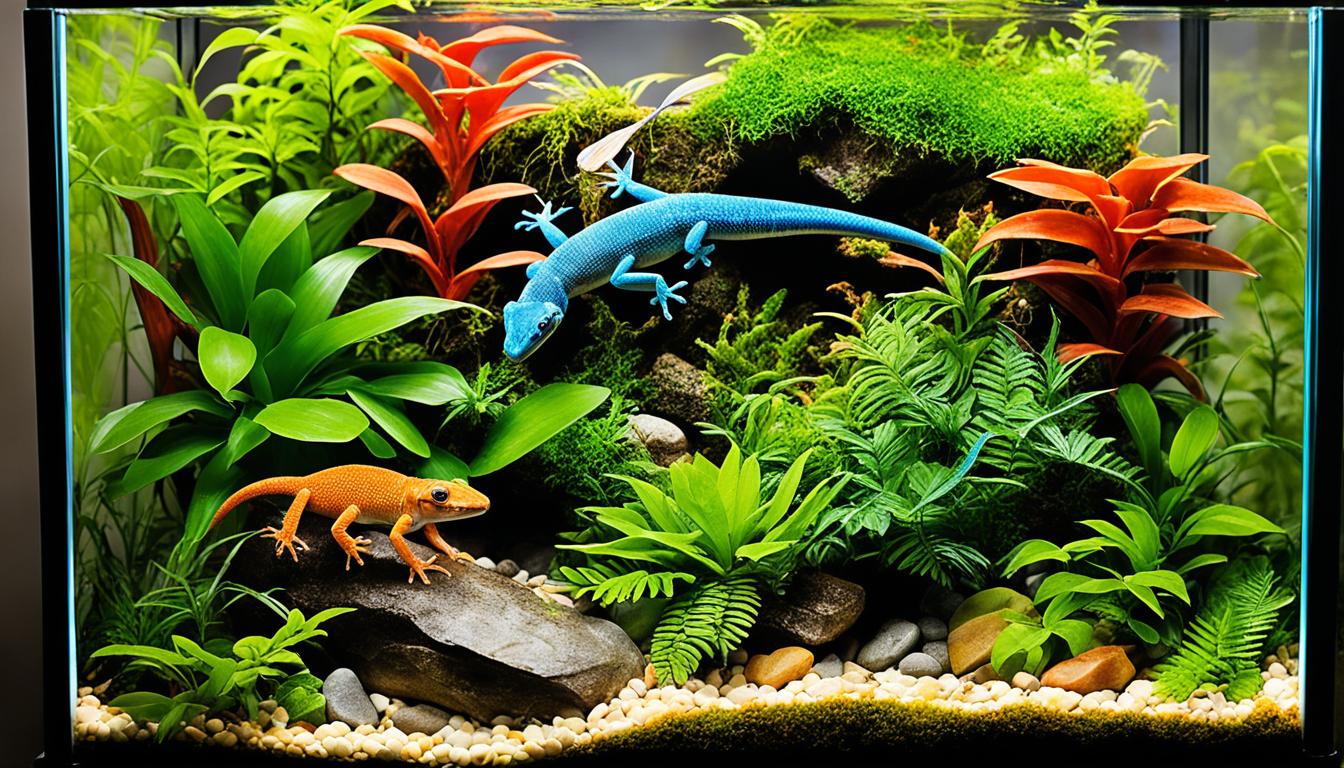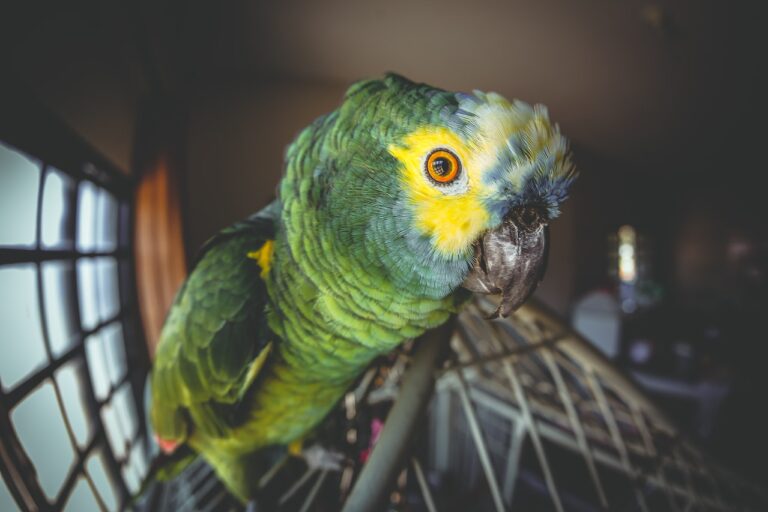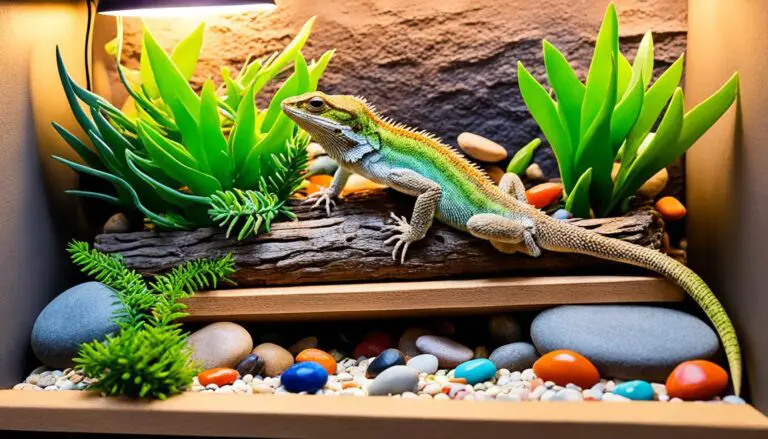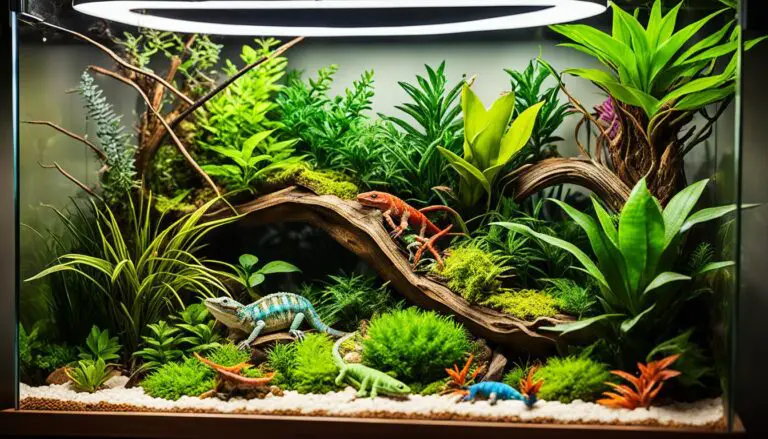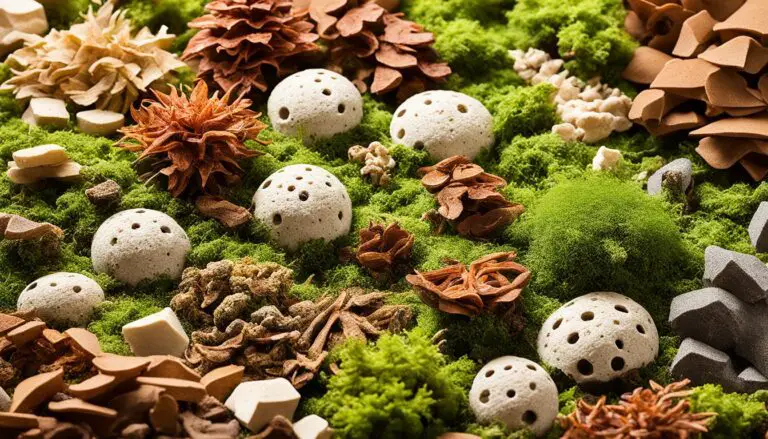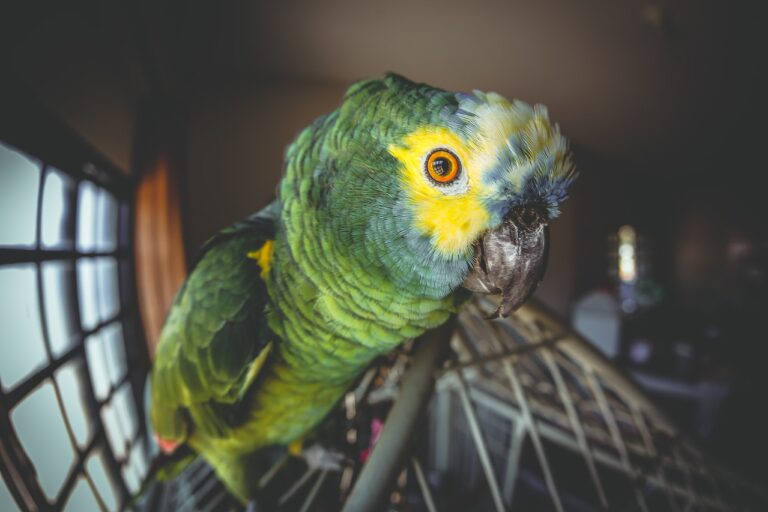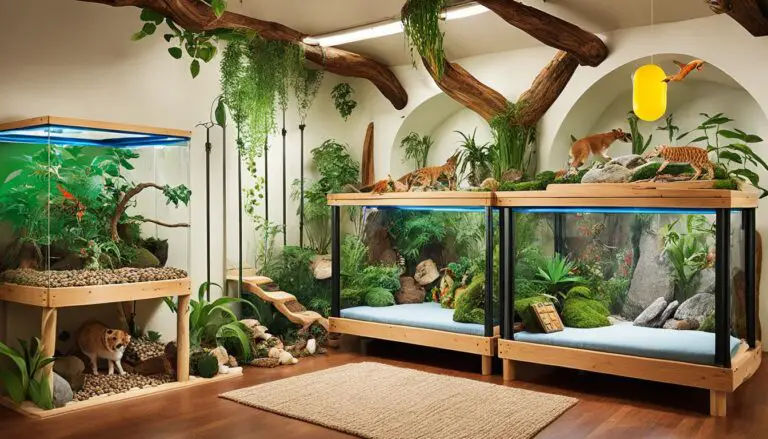Creative Exotic Pet Terrarium Ideas Unveiled
Are you looking for creative ideas to design a unique and captivating terrarium for your exotic pet? Look no further! In this article, we will explore a variety of exotic pet terrarium ideas, including unique reptile enclosure designs, creative vivarium setups, and DIY habitats that will inspire you to create a thriving and visually stunning home for your pet.
Key Takeaways:
- Discover unique reptile enclosure designs and creative vivarium setups for your exotic pet.
- Explore DIY exotic pet habitat ideas that allow you to personalize and design a one-of-a-kind terrarium.
- Find inspiration for terrarium decoration and landscaping to create visually appealing and stimulating environments.
- Learn about the best terrarium plants, accessories, and setup tips for exotic pets.
- Create a comfortable and enriching habitat that mimics your pet’s natural environment with attention to detail and creativity.
DIY Exotic Pet Habitat Ideas
Creating your own exotic pet habitat is a fun and creative project that allows you to design a unique and personalized terrarium. By incorporating DIY exotic pet habitats, you can provide a comfortable and stimulating environment for your beloved pets. Whether you have a reptile, amphibian, or invertebrate, designing a habitat that closely mimics their natural environment is essential for their well-being.
To get started, gather materials such as rocks, plants, and decorative elements that are suitable for your pet’s specific needs. Research the particular requirements of your pet species and ensure you provide the appropriate environment in terms of lighting, temperature, and humidity. This will help you create an environment that promotes your pet’s physical and mental health.
When it comes to terrarium decoration inspiration, the possibilities are endless. You can create stunning landscapes by combining different textures, colors, and elements. Use natural rocks and driftwood to create hiding spots and climbing structures. Incorporate live plants to not only enhance the aesthetics but also to provide oxygen and a sense of natural habitat for your pets.
Here are some DIY terrarium setup tips to guide you in creating an inviting habitat for your exotic pet:
- Research the specific needs of your pet species, including temperature, humidity, and lighting requirements.
- Choose a suitable terrarium size based on your pet’s size and space needs.
- Use a proper substrate that promotes drainage and is suitable for your pet’s species.
- Incorporate hideouts and climbing structures to provide a sense of security and opportunities for exercise.
- Create a balanced environment with appropriate heating and UVB lighting.
Here is an example of how you can set up a DIY exotic pet habitat for a leopard gecko:
| Terrarium Setup | Supplies |
|---|---|
| Substrate | Coconut fiber or reptile carpet |
| Hiding Spots | Rock caves and hollowed logs |
| Climbing Structures | Artificial plants and branches |
| Heating | Under-tank heating pad |
| Lighting | Leopard gecko-specific UVB bulb |
Remember to always monitor the temperature and humidity levels regularly to ensure they remain within the optimal range for your pet’s species. Additionally, provide a clean and healthy habitat by regularly cleaning the terrarium and replacing any soiled substrate or decorations.
“Designing a DIY exotic pet habitat allows you to create a personalized space that not only caters to your pet’s needs but also showcases your creativity.”
With careful planning and attention to detail, you can design a stunning and functional DIY exotic pet habitat that provides a comfortable and enriching environment for your pets. Enjoy the process and let your imagination run wild as you create a terrarium that is truly unique to your pet’s needs and preferences.
Unique Terrarium Designs for Exotic Pets
When it comes to designing a terrarium for your exotic pet, the possibilities are endless. You have the opportunity to create unique terrarium designs that perfectly cater to your pet’s specific needs and natural habitat. By incorporating custom reptile tank layouts and carefully selected natural elements, you can design a visually appealing and stimulating environment for your beloved pet.
One key aspect of creating a unique terrarium design is the use of custom reptile tank layouts. These layouts allow you to tailor the terrarium to your pet’s requirements, ensuring that their living space is optimized for their health and well-being. Consider the specific needs of your exotic animal in terms of space, hiding spots, and climbing structures, and design the tank accordingly.
In addition to custom tank layouts, the incorporation of natural elements is essential in creating a unique terrarium design. Adding branches, rocks, and plants not only enhances the visual appeal of the terrarium but also provides a stimulating environment for your pet. Research the natural habitat of your exotic animal and try to recreate elements of it within the terrarium to closely resemble their native surroundings.
For example, if you have a reptile that thrives in a tropical rainforest environment, you can include lush plants, vines, and a small water feature to mimic their natural habitat. Similarly, if you have a desert-dwelling species, incorporating desert plants, sand substrate, and strategically placed rocks can create a terrarium that closely resembles their arid surroundings.
Benefits of Unique Terrarium Designs
A unique terrarium design offers several benefits for both you and your exotic pet:
- Enrichment: By creating a visually appealing and stimulating environment, a unique terrarium design provides enrichment for your pet, stimulating their natural behaviors and promoting overall well-being.
- Aesthetic Appeal: A unique terrarium design adds a touch of beauty and personalization to your pet’s habitat, creating a captivating display piece that you can proudly showcase in your home.
- Physical and Mental Stimulation: The inclusion of natural elements, custom layouts, and carefully chosen decorations in your terrarium design creates opportunities for physical exercise and mental stimulation for your pet.
- Comfort: A unique terrarium design ensures that your pet’s habitat is optimized for their specific needs and preferences, providing them with a comfortable and secure space to thrive.
With creativity, careful planning, and consideration for your pet’s requirements, you can design a unique terrarium that truly reflects their individuality and provides a comfortable and enriching habitat for your exotic pet.

Comparing Different Terrarium Designs
| Terrarium Design | Features | Recommended Exotic Pets |
|---|---|---|
| Natural Rainforest Terrarium | – Lush plants and vines – Small water feature – Branches and climbing structures |
– Green tree pythons – Poison dart frogs – Veiled chameleons |
| Desert Biome Terrarium | – Desert plants and succulents – Sand substrate – Rocks and burrowing spots |
– Bearded dragons – Leopard geckos – Desert tortoises |
| Aquatic Habitat Terrarium | – Aquatic plants and floating logs – Water filtration and heating – Rock formations for basking |
– Axolotls – Red-eared sliders – African clawed frogs |
Terrarium Plants for Exotic Pets
When creating a terrarium for your exotic pets, choosing the right plants is crucial for providing a thriving habitat. Researching and selecting the best terrarium plants for your pets ensures that they will flourish in the conditions provided by your terrarium. Additionally, incorporating terrarium accessories can enhance your pet’s experience and create a more realistic environment that mimics their natural habitat.
Best Terrarium Plants for Pets
Here are some of the top plant species that thrive in terrarium environments and are ideal for exotic pets:
- Nepenthes – Also known as pitcher plants, these unique carnivorous plants add a touch of exotic beauty to your terrarium. They thrive in high humidity and require bright, indirect light.
- Fittonia – With their vibrant foliage, Fittonia plants, also called nerve plants, are an excellent choice for adding color to your terrarium. They prefer moist, well-draining soil and thrive in indirect light.
- Pilea – Pilea plants, often referred to as friendship plants, have charming round leaves and are easy to care for. They prefer bright, indirect light and moderate humidity.
- Dracaena – Dracaena plants, known for their variegated foliage, are an excellent choice for larger terrariums. They thrive in moderate to bright indirect light and prefer soil that is kept evenly moist.
- Peperomia – Peperomia plants come in a variety of unique leaf shapes and patterns, making them a popular choice for terrariums. They prefer well-draining soil and thrive in moderate to bright indirect light.
Remember to research each plant species’ specific care requirements, including lighting, temperature, and humidity levels, to ensure they are compatible with your pet’s needs.
Terrarium Accessories for Exotic Pets
In addition to the right plants, incorporating terrarium accessories can enhance your exotic pet’s experience and contribute to a more natural habitat. Consider the following accessories:
- Hiding spots – Providing hiding spots, such as caves or plant cover, gives your pet a sense of security and allows them to exhibit natural behaviors.
- Climbing structures – Exotic pets often enjoy climbing and exploring their surroundings. Adding branches or vines to your terrarium creates opportunities for exercise and enrichment.
- Water features – Depending on your pet’s needs, adding a small water feature can provide a drinking source or a place for amphibious species to swim.
By incorporating these accessories, you can create a more dynamic and engaging habitat for your exotic pets, promoting their overall well-being and enjoyment.
Comparison of Terrarium Plants for Exotic Pets
| Plant Species | Lighting Requirements | Watering Needs | Temperature Range |
|---|---|---|---|
| Nepenthes | Bright indirect light | Keep soil moist but not waterlogged | 60°F – 80°F |
| Fittonia | Indirect light | Keep soil evenly moist | 65°F – 75°F |
| Pilea | Bright indirect light | Allow soil to dry slightly between waterings | 60°F – 75°F |
| Dracaena | Moderate to bright indirect light | Allow soil to dry between waterings | 65°F – 80°F |
| Peperomia | Moderate to bright indirect light | Allow soil to dry between waterings | 60°F – 75°F |
Terrarium Setup Tips for Unusual Pets
Creating a terrarium setup for unusual pets requires careful attention to their unique needs. Each exotic animal has specific requirements for temperature, humidity, lighting, and substrate. To ensure the well-being of your unusual pet, it’s essential to research and implement terrarium setup tips tailored to their specific needs. Here are some guidelines to help you create a suitable habitat:
1. Research and Understand Your Pet’s Requirements
Take the time to thoroughly research your pet species to understand their specific habitat requirements. Consider factors such as temperature range, humidity levels, lighting preferences, and substrate needs. This knowledge will serve as a foundation for creating a suitable terrarium environment.
2. Create Hiding Places
Unusual pets often require hiding places to feel secure and reduce stress. Depending on the size and behavior of your pet, you can incorporate natural hideouts, such as rocks, logs, or artificial caves, into the terrarium setup. This will provide your pet with the necessary privacy and a sense of security in their environment.
3. Provide Proper Ventilation
Ventilation is crucial for maintaining fresh air circulation and preventing the buildup of harmful gases within the terrarium. Ensure that your terrarium has adequate ventilation openings or a mesh top to allow for proper air exchange. This will contribute to the overall health and well-being of your unusual pet.
4. Maintain Proper Temperature Gradients
Many unusual pets have specific temperature requirements. It is essential to provide a temperature gradient within the terrarium to allow your pet to regulate their body temperature effectively. Consider installing a heat source, such as heat mats or basking lamps, to create warm areas and cooler zones within the habitat.
5. Seek Inspiration from Terrariums Designed for Exotic Animals
Take inspiration from terrarium setups designed for other exotic animals. This can provide valuable insights and ideas that will help you create a suitable and visually appealing habitat for your unusual pet. Additionally, observing successful terrarium designs can help you identify and address any potential challenges in your own setup.
By following these terrarium setup tips, you can create a safe and comfortable environment for your unusual pet. Remember to regularly monitor and adjust the terrarium conditions based on your pet’s needs. With proper research and careful consideration, you can provide a thriving habitat for your exotic companion.
| Terrarium Setup Tips for Unusual Pets | |
|---|---|
| Research and Understand Your Pet’s Requirements | Thoroughly research the specific needs of your unusual pet, including temperature, humidity, lighting, and substrate requirements. |
| Create Hiding Places | Provide natural or artificial hiding places to allow your pet to feel secure and reduce stress. |
| Provide Proper Ventilation | Ensure proper air circulation and exchange within the terrarium by incorporating ventilation openings or a mesh top. |
| Maintain Proper Temperature Gradients | Create warm and cool areas within the terrarium to allow your pet to regulate their body temperature. |
| Seek Inspiration from Terrariums Designed for Exotic Animals | Take ideas and insights from successful terrarium setups created for other exotic animals. |

Setting up a terrarium for an unusual pet requires careful attention to their unique needs, such as temperature, humidity, lighting, and substrate requirements. Incorporating terrarium setup tips specific to your pet’s needs will help create a suitable habitat. Researching the requirements, providing hiding places, ensuring proper ventilation, maintaining temperature gradients, and seeking inspiration from successful terrarium designs are all essential steps to a successful setup.
Terrarium Decoration Inspiration
When it comes to creating a captivating and visually stunning habitat for your exotic pet, finding terrarium decoration inspiration is key. By gathering ideas from various sources, you can design a unique and personalized terrarium that mimics your pet’s natural environment. Whether you look online, observe nature, or connect with other hobbyists, there are countless sources of inspiration to explore.
One popular way to enhance the aesthetic appeal of your terrarium is by incorporating terrarium accessories. These accessories can include artificial plants, decorative rocks, and substrate options that add texture, color, and visual interest to your pet’s habitat.
Additionally, using different materials and colors can provide a visually stimulating environment for your pet. Consider experimenting with a variety of textures, such as smooth rocks, rough bark, and lush vegetation, to create an engaging and natural-looking terrarium landscape.
To further enhance your pet’s habitat, you can also incorporate themed decorations that reflect their natural habitat. For example, if your exotic pet comes from a tropical rainforest environment, you could include miniature trees, vines, and water features to recreate that lush and vibrant atmosphere.
“A well-designed terrarium can transport your exotic pet to their native habitat and provide them with a sense of comfort and security.”
Remember to consider the specific needs of your pet species when selecting terrarium decorations. Some species may require hiding spots, climbing structures, or specific types of plants to create an optimal environment.
Below is an example of a terrarium decoration inspiration table:
| Terrarium Decoration Ideas | Description |
|---|---|
| Naturalistic Branches | Provide climbing surfaces and perches for arboreal species. |
| Lush Mosses | Add vibrant greenery and create a natural feel. |
| Artificial Waterfall | Create a visually appealing focal point and stimulate natural behaviors. |
| Underwater Caves | Offer hiding spots for aquatic species. |
As you can see above, there are many terrarium decoration ideas that can bring life and excitement to your pet’s environment. Remember to always prioritize your pet’s well-being by considering their specific needs and preferences when selecting decorations.
Additional Tips:
- Research your pet species to understand their natural habitat and preferences.
- Experiment with different arrangements and layouts to create a visually appealing terrarium.
- Regularly clean and maintain your terrarium to ensure a healthy and safe environment for your pet.
Innovative Terrarium Landscaping Ideas
When it comes to terrarium landscaping, innovative ideas can help create a visually striking and functional environment for your exotic pet. By incorporating unique elements like water features, miniature landscapes, and naturalistic textures, you can design a captivating terrarium that stands out from the rest. Experimenting with different terrarium setup tips will allow you to create varying levels, hiding spots, and climbing structures that cater to your pet’s specific needs and preferences.
One idea for innovative terrarium landscaping is to incorporate water features. Whether it’s a small waterfall, a bubbling pond, or a gently flowing stream, water elements can add a touch of tranquility and mimic the natural habitat of certain exotic pets. Not only do they provide visual appeal, but they also create a source of hydration and enrichment for your pet.

Another creative terrarium landscaping idea is to create miniature landscapes within the enclosure. You can use materials like rocks, sand, gravel, and moss to mimic different terrains such as deserts, forests, or rocky landscapes. Adding small plants, trees, or even artificial structures can enhance the visual appeal and make your terrarium feel like a miniaturized version of the natural world.
When designing your terrarium, don’t forget to consider naturalistic textures. Incorporating elements like tree branches, vines, and rocks not only provide climbing and hiding opportunities for your pet but also create a more realistic and visually engaging environment. These textures can mimic the natural habitats of exotic animals and make them feel more at home in their terrarium.
“Innovative terrarium landscaping allows you to design a visually striking and functional habitat for your exotic pet.”
By seeking inspiration from exotic terrarium display ideas, you can get a better understanding of the various possibilities and create a one-of-a-kind habitat for your pet. Explore different themes, styles, and arrangements to find the perfect design that suits your pet’s needs and preferences.
Terrarium Setup Tips for Innovative Landscaping
When implementing innovative landscaping ideas in your terrarium, it’s important to keep in mind some essential terrarium setup tips:
- Create different levels and platforms to provide vertical space and opportunities for your pet to explore and climb.
- Add hiding spots and shelters using rocks, plants, or artificial structures to provide a sense of security for your pet.
- Consider the lighting needs of your pet’s habitat and arrange the terrarium accordingly to ensure proper illumination.
- Maintain appropriate temperature and humidity levels to support the growth of plants and the overall health of your pet.
- Regularly monitor and adjust the terrarium landscape to accommodate the growth and needs of the plants and your pet.
Keep in mind that terrarium landscaping is a continuous process, and you can always experiment with different ideas and layouts to create a unique and visually appealing environment for your exotic pet.
Creative Vivarium Setups for Exotic Pets
Vivarium setups offer a fascinating opportunity to design unique and personalized habitats for your exotic pets. By combining live plants, naturalistic decorations, and appropriate enclosure design, you can create a visually appealing and functional vivarium. Let your creativity soar as you explore various elements to enhance your pet’s habitat.
Live Plants
One way to bring vibrant life into your vivarium is by incorporating live plants. Choose species that are suitable for your pet’s habitat and thrive in the conditions provided by the vivarium. Not only do live plants add visual appeal, but they also provide hiding spots and contribute to the overall ecosystem within the enclosure.
Naturalistic Decorations
Enhance the natural beauty of your vivarium by adding naturalistic decorations. Use rocks, branches, and driftwood to create climbing structures and perches for your pets. These elements not only serve as functional features but also add an aesthetic touch, mimicking the natural environments of exotic animals.
Water Features
Introduce the soothing sounds of flowing water into your vivarium by incorporating a water feature. Whether it’s a small pond, cascading waterfall, or a simple water dish, a water feature creates an enriching and interactive element within the habitat. Remember to consider your pet’s species-specific requirements when including a water feature.
DIY Terrarium Projects
Add a personal touch to your vivarium by engaging in DIY terrarium projects. Get creative with custom backgrounds, artistic displays, and unique enclosure designs. Let your imagination run wild as you turn your vivarium into a work of art that showcases the natural beauty of your exotic pet’s habitat.
Temperature-Controlled Zones
Creating temperature-controlled zones within your vivarium allows you to provide various heat gradients required by different reptiles and amphibians. Utilize heating mats, heat lamps, or under-tank heaters to maintain optimal temperatures for your pet’s comfort and well-being.
| Benefits of Creative Vivarium Setups | Examples |
|---|---|
|
|
With careful planning and attention to detail, you can transform a simple vivarium into a breathtaking living masterpiece. Explore creative vivarium setups, experiment with different elements, and watch your exotic pet thrive in its enhanced habitat.
Terrarium Setup Tips for Exotic Animals
Setting up a terrarium for exotic animals requires careful planning and consideration of their specific needs. By creating an environment that closely mimics their natural habitat, you can ensure your pets thrive and flourish. Here are some terrarium setup tips to help you provide the best possible living conditions for your exotic pets.
- Research Ideal Environmental Conditions: Before setting up your terrarium, research the ideal temperature, humidity, and lighting requirements for your specific pet species. Understanding their natural habitat will guide you in creating the most suitable environment for them.
- Use Custom Reptile Tank Layouts: Custom reptile tank layouts allow you to tailor the terrarium to your pet’s natural behaviors and preferences. Consider incorporating hiding spots, climbing structures, and basking areas to provide them with a sense of security and comfort.
- Incorporate Terrarium Decorating Tips: Decorating your terrarium not only adds visual appeal but also provides stimulation for your exotic animals. Use natural elements like rocks, branches, and plants to create a visually appealing and stimulating environment that resembles their natural habitat.
- Provide Hiding Spots and Climbing Structures: Exotic animals often rely on hiding spots and climbing structures to feel safe and secure. Make sure to include various options within the terrarium to cater to their natural instincts and behaviors.
Remember to always prioritize the well-being and comfort of your exotic pets when setting up their terrarium. By following these terrarium setup tips, you can create a thriving environment that supports the health and happiness of your beloved pets.

Expert Tip:
“When designing a terrarium for exotic animals, it’s crucial to strike a balance between aesthetics and functionality. Incorporate natural elements that allow your pets to exhibit their natural behaviors, while also creating a visually appealing habitat.”
Terrarium Accessories for Exotic Pets
Terrarium accessories are essential for creating the perfect habitat for your exotic pet. By incorporating the right accessories, you can enhance both the functionality and overall aesthetic appeal of the terrarium. From heating mats and lighting systems to misting devices, there are various accessories to consider based on your pet’s specific needs and preferences.
When selecting terrarium accessories, it’s crucial to ensure proper placement and functionality within the terrarium. Follow these terrarium setup tips to maximize the benefits of each accessory and provide the ideal environment for your exotic pet. Whether it’s placing the heating mat in a spot that creates a comfortable basking area or positioning the misting device to maintain optimal humidity levels, proper installation is key to your pet’s well-being.
For inspiration, look to exotic terrarium display ideas that showcase unique and visually appealing accessories. By incorporating these ideas into your own terrarium design, you can create a captivating habitat that not only meets the practical needs of your pet but also reflects their natural environment.
Recommended Terrarium Accessories for Exotic Pets
| Accessory | Function |
|---|---|
| Heating Mats | Provide a warm basking area for reptiles and amphibians |
| Lighting Systems | Ensure proper illumination for photosynthesis and pet visibility |
| Misting Devices | Maintain optimal humidity levels for tropical species |
| Hiding Spots | Gives pets a place to retreat and feel secure |
| Climbing Structures | Allows for natural movement and exercise |
| Water Features | Provides a water source for aquatic species |
Remember, each accessory should be selected with your pet’s specific needs in mind. Conduct thorough research and consult with experts to determine the appropriate accessories for your exotic pet and ensure their overall well-being.
Conclusion
Terrariums provide a captivating and unique opportunity to create vibrant and comfortable habitats for exotic pets. By incorporating creative pet habitat ideas, innovative terrarium landscaping, and following terrarium setup tips, pet owners can design personalized habitats that cater to their pet’s needs while offering visual appeal. With attention to detail and a sense of creativity, terrariums become works of art that showcase the beauty of exotic animals and provide a fulfilling and enriching environment for both pets and owners.
To create a thriving ecosystem within a terrarium, it’s important to consider terrarium accessories, unique terrarium designs, and appropriate plant selections. Including accessories like heating mats, lighting systems, and misting devices can help maintain the ideal environment for your pet. Customizing your terrarium design with natural elements like rocks, branches, and plants can provide a visually appealing and stimulating environment. Selecting suitable terrarium plants that mimic your pet’s natural habitat is crucial for their well-being and ensures a thriving ecosystem.
With terrarium setup tips and creative pet habitat ideas, you can create a personalized and visually stunning terrarium that provides a comfortable and enriching environment for your exotic pet. Remember to research the specific needs of your pet species to maintain optimal living conditions. By embracing the art of terrarium design, you can create a unique and captivating habitat that reflects the natural beauty of exotic animals.
FAQ
What are some creative exotic pet terrarium ideas?
How can I create a DIY exotic pet habitat?
What are some unique terrarium designs for exotic pets?
What are the best terrarium plants for exotic pets?
What are some terrarium setup tips for unusual pets?
Where can I find terrarium decoration inspiration?
How can I create innovative terrarium landscaping?
What are some creative vivarium setups for exotic pets?
What are some terrarium setup tips for exotic animals?
What are some terrarium accessories for exotic pets?
How can I ensure a thriving terrarium setup for my exotic pet?
Source Links
- https://be.green/en/blog/terrariums-the-perfect-option-for-those-who-love-nature
- https://www.stormthecastle.com/terrarium/fish-tank-terrarium.htm
- https://medium.com/@productfindsspotlight/the-options-of-terrariums-a-guide-to-creating-and-caring-for-your-miniature-ecosystem-c4ead567da79
Peter Stones is the founder of Exotic Pets Place, the leading online resource for exotic pet care information.
With over 10 years of hands-on exotic pet ownership experience, he is deeply passionate about sharing his expertise to help others properly care for their unusual pets.
When he's not writing extensively researched articles or connecting with fellow exotic pet enthusiasts worldwide, you can find Peter at home tending to his own beloved menagerie of exotic animals.

